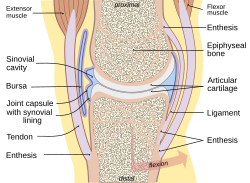Enthesis
| Enthesis | |
|---|---|
 Typical joint | |
| Identifiers | |
| TH | H3.03.00.0.00034 |
| Anatomical terminology | |
The enthesis (plural entheses) is the connective tissue between tendon or ligament and bone.[1]
There are two types of entheses: Fibrous entheses and fibrocartilaginous entheses.[2][3]
In a fibrous enthesis, the collagenous tendon or ligament directly attaches to the bone.
In a fibrocartilaginous enthesis, the interface presents a gradient that crosses four transition zones:[4]
- Tendinous area displaying longitudinally oriented fibroblasts and a parallel arrangement of collagen fibres
- Fibrocartilaginous region of variable thickness where the structure of the cells changes to chondrocytes
- Abrupt transition from cartilaginous to calcifiedfibrocartilage—often called 'tidemark' or 'blue line'
- Bone
Clinical significance
A disease of the entheses is known as an enthesopathy or enthesitis.[5]
Enthetic degeneration is characteristic of spondyloarthropathy and other pathologies.
The enthesis is the primary site of disease in ankylosing spondylitis.
Society and culture
Bioarchaeology
Entheses are widely recorded in the field of bioarchaeology where the presence of anomalies at these sites, called entheseal changes, has been used to infer repetitive loading to study the division of labour in past populations.[6] Several different recording methods have been proposed to record the variety of changes seen at these sites.[7][8][9][10][11][12][13][14][15] However, research has shown that, whichever recording method is used, entheseal changes occur more frequently in older individuals.[16][8][17][18][19] Research demonstrates that diseases, such as ankylosing spondylitis and calcific tendinitis,[20] also have to be taken into consideration. Experimental studies have demonstrated how loading history (physical activity) can increase the relative size of muscle attachment sites.[21][22][23][24]
History
"Enthesis" is rooted in the Ancient Greek word, "ἔνθεσις" or "énthesis," meaning “putting in," or "insertion." This refers to the role of the enthesis as the site of attachment of bones with tendons or ligaments. Relatedly, in muscle terminology, the insertion is the site of attachment at the end with predominant movement or action (opposite of the origin). Thus the words (enthesis and insertion [of muscle]) are proximal in the semantic field, but insertion in reference to muscle can refer to any relevant aspect of the site (i.e., the attachment per se, the bone, the tendon, or the entire area), whereas enthesis refers to the attachment per se and to ligamentous attachments as well as tendinous ones.
See also
References
- ^ "enthesis". Medcyclopaedia. GE. Archived from the original on 2012-02-05.
- ISBN 9781461433163.
- PMID 24326955.
- PMID 28541313.
- PMID 16637873.
- ISBN 9781444345940.
- ISSN 1099-1212.
- ^ S2CID 145571511.
- ISSN 1099-1212.
- PMID 15636072.
- PMID 17598416.
- ^ Villotte S. "Practical protocol for scoring the appearance of some fibrocartilaginous entheses on the human skeleton".
- PMID 20034011.
- S2CID 3902457.
- PMID 27166777.
- ISSN 1099-1212.
- PMID 26239396.
- PMID 22460619.
- S2CID 29420179.
- S2CID 3916560.
- PMID 31719626.
- PMID 31712353.
- PMID 34519035.
- S2CID 256486347.
External links
- Enthesis information site at www.enthesis.info
- Image of enthesis at Medscape
- Enthesopathy and Soft Tissue Shadows at chiroweb.com
Further reading
- Resnick D, Niwayama G (January 1983). "Entheses and enthesopathy. Anatomical, pathological, and radiological correlation". Radiology. 146 (1): 1–9. PMID 6849029.
